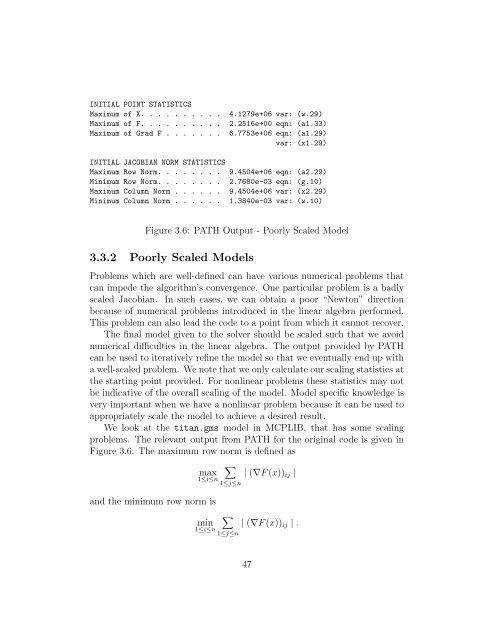GAMS/PATH User Guide Version 4.3
GAMS/PATH User Guide Version 4.3
GAMS/PATH User Guide Version 4.3
You also want an ePaper? Increase the reach of your titles
YUMPU automatically turns print PDFs into web optimized ePapers that Google loves.
INITIAL POINT STATISTICS<br />
Maximum of X. . . . . . . . . . 4.1279e+06 var: (w.29)<br />
Maximum of F. . . . . . . . . . 2.2516e+00 eqn: (a1.33)<br />
Maximum of Grad F . . . . . . . 6.7753e+06 eqn: (a1.29)<br />
var: (x1.29)<br />
INITIAL JACOBIAN NORM STATISTICS<br />
Maximum Row Norm. . . . . . . . 9.4504e+06 eqn: (a2.29)<br />
Minimum Row Norm. . . . . . . . 2.7680e-03 eqn: (g.10)<br />
Maximum Column Norm . . . . . . 9.4504e+06 var: (x2.29)<br />
Minimum Column Norm . . . . . . 1.3840e-03 var: (w.10)<br />
Figure 3.6: <strong>PATH</strong> Output - Poorly Scaled Model<br />
3.3.2 Poorly Scaled Models<br />
Problems which are well-defined can have various numerical problems that<br />
can impede the algorithm’s convergence. One particular problem is a badly<br />
scaled Jacobian. In such cases, we can obtain a poor “Newton” direction<br />
because of numerical problems introduced in the linear algebra performed.<br />
This problem can also lead the code to a point from which it cannot recover.<br />
The final model given to the solver should be scaled such that we avoid<br />
numerical difficulties in the linear algebra. The output provided by <strong>PATH</strong><br />
can be used to iteratively refine the model so that we eventually end up with<br />
a well-scaled problem. We note that we only calculate our scaling statistics at<br />
the starting point provided. For nonlinear problems these statistics may not<br />
be indicative of the overall scaling of the model. Model specific knowledge is<br />
very important when we have a nonlinear problem because it can be used to<br />
appropriately scale the model to achieve a desired result.<br />
We look at the titan.gms model in MCPLIB, that has some scaling<br />
problems. The relevant output from <strong>PATH</strong> for the original code is given in<br />
Figure 3.6. The maximum row norm is defined as<br />
max<br />
and the minimum row norm is<br />
<br />
1≤i≤n<br />
1≤j≤n<br />
min<br />
<br />
1≤i≤n<br />
1≤j≤n<br />
| (∇F (x))ij |<br />
| (∇F (x))ij | .<br />
47

















